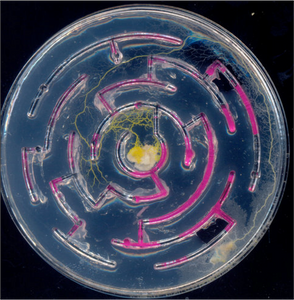“No Brain? No Problem!”
…Says the slime mold before the zombie ate its brain centuries ago, forcing the whole species to adapt into its present state: brainless yet smart.

Slime molds avoid bright light. In A, there was none, so molds grew to food (yellow puncta) freely while in B and C there were differing shades of light to influence its growth, which is surprisingly comparable to the real Tokyo rail network in D. E and F show minimum spanning trees (see third source below).
Okay, the zombie part isn’t entirely accurate, BUT, these slime molds (the gelatinous amoebae also known as the protist, Physarum polycephalum) do seem to have no problem functioning without a brain. They can navigate complex mazes for food, choose healthy over less nutritious food, and determine the shortest route between points of interest – a feat that takes humans years when designing complex transportation systems. How could this be?
Scientists have been studying this protist for over thirty years, taking it to the lab from its natural environment, where it has searched for food in leaf litter and along tree limbs to envelop and digest for at least 600 million years (essentially, dumpster diving before it was cool). Following studies in the early 2000s by Toshiyuki Nakagaki at Hokkaido University in Japan, Chris Reid at the University of Sydney observed that slime molds avoid spots they have traveled on, which was thought to demonstrate an externalized spatial memory that encourages exploration. Additionally, when placing the molds in a dish with dry acetate blocking access to food, Reid observed that molds navigated around the obstacle to the food. However, when he added extracellular slime prior to placing the molds in the dish, he noted that the molds had significantly less success finding the food, demonstrating they were “confused” and could no longer map areas traveled.

Time lapse of slime mold starting at "Tokyo" in an experimental arena and creating a network between major cities in white marked by pieces of food (third source below).
Other studies how shown how slime molds can choose optimal travel routes and foods. As a pretty good “shape-shifter,” flattening, thinning, and accumulating as needed, slime molds have been seen to leave areas that are dead-ends in mazes in favor of areas that lead to food. Slime molds similarly left or thinned out in areas that were less optimal, leaving behind interconnected routes that resembled rail-lines and main roads in places like Tokyo. Although the protists may not get paid for their unexpected proficiency in navigation, they may be used in the planning of future transportation routes or to create computer models simulating their decision-making processes, suggests some researchers.
Slime molds not only navigate surprisingly well, they have also been suggested to have internal clocks. Tetsu Saigusa, also at Hokkaido University, found that these internal clocks may allow slime molds to anticipate events by monitoring the rhythmic pulsing of their cytoplasm (also responsible for flowing from one region to another though periodic constrictions and relaxations). When subjected to unfavorable conditions periodically, slime molds slowed their cytoplasmic pulsing. For some slime molds, this slowing trend continued even when exposed to consistently favorable conditions. Eventually, even those molds ceased the slowing of their pulsing, enjoying the good life of humidity and high temperatures.
And apparently, a good life means good food too. Slime molds have been shown to choose the best balance between carbohydrates and proteins when placed near one protein-rich food and one carbohydrate-rich food through adjusting their size. In one study, Dr. Beekman at the University of Sydney placed 3% and 5% oat flakes under bright lights, which slime molds try to avoid (despite liking heat and humidity). The slime molds traveled from dark to light areas for the oat flakes but without a preference of percentage. However, when 1% oat flakes were placed in the dark, they went to the 1% oat flake, suggesting that, like humans, slime molds choose based on relative, not absolute, values, deciding based on priorities.
Certainly, slime molds seem to be prioritizing and optimizing their behaviors. Scientists have been trying to sequence the DNA of the many species of slime molds to explore how they have evolved, and to elucidate what allows the organism to retain memories and optimize decisions.
The question then remains, are these protists an “intelligent” species? As a human and a neuroscience major, I have been taught the importance of centralized nervous systems to intelligence. Then this slime mold comes along, leaving behind externalized memory traces and optimizing its decisions lacking anything even close to a brain. Where’s its hippocampus? Does it not have a dentate gyrus? Where are the granule cells? Neuroscientists, biologists, scientists, psychologists, and so on must then wonder, what makes an organism intelligent? What are the anatomical and functional criteria? One thing is certain, these slimy protists are challenging our understanding of intelligence, one disgusting, oat flake-coated petri dish at a time.
Sources:
Physarum Music – YouTube
How Brainless Slime Molds Redefine Intelligence [Video] – Scientific American
Rules for Biologically Inspired Adaptive Network Design – Science
Can Answers to Evolution Be Found in Slime? – The New York Times


